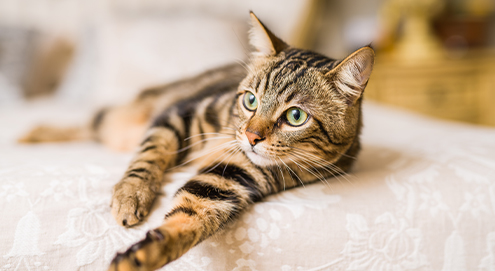Causes of ear infections in cats
If a cat develops an ear infection, it is usually due to one of the following causes:
- Ear mites
- Middle ear polyps
- Middle ear infection
- Allergy
Ear infection in cats caused by ear mites
In cats that spend time outdoors, ear mites are a common cause of ear infections. These small, spider-like parasites feed on earwax and are difficult to see with the naked eye. They cause severe itching, leading to scratching and discomfort. Ear mites are most common in young cats. To eliminate them, it’s important to use an antiparasitic treatment together with ear drops, such as Clean Ear Cleaner.
Ear infection caused by middle ear polyps
Cats can develop polyps in the middle ear, which may break through the eardrum and grow into the ear canal, causing blockage. This irritates the ear canal and can lead to infection. Polyps are benign swellings of the middle ear’s mucous membrane and often look like small mushrooms. Infections of the upper respiratory tract, such as cat flu, are a common cause. These polyps are also more frequently seen in pedigree cats, such as the Maine Coon.
Middle ear infection in cats
Middle ear infections occur more often in cats than in dogs. They usually develop due to an infection ascending from the upper respiratory tract. Cats often show only vague symptoms, so the problem may remain unnoticed for some time, showing only signs like reduced appetite or lethargy.
Some cats with a middle ear infection develop facial paralysis (Facialis Paralysis), meaning the facial nerve is affected, resulting in a drooping lip, eyelid, and ear. Horner’s syndrome may also occur, as well as coordination problems caused by damage to the balance organ. Sometimes, a CT scan is required to confirm the diagnosis.
Ear infection in cats caused by an allergy
As in dogs, an allergy is a common cause of ear infections in cats. Allergies can be difficult to diagnose, and treatment options in cats are more limited than in dogs.
Symptoms of an ear infection
The symptoms of an ear infection are often quite noticeable: the cat shakes its head, scratches its ear, and may show signs of pain. The affected ear is often held low. The inside of the ear may appear red or dirty, and it may emit an unpleasant smell or discharge. In more serious cases, such as a middle ear infection, the balance organ may be affected, resulting in more severe symptoms like head tilting, balance issues, or even falling over. A thorough veterinary examination is essential to determine the exact cause, such as ear mites or a bacterial/fungal infection. In some cases, further tests like an ear swab culture or X-ray may be required.
What to do if your cat has an ear infection
If your cat has ear problems, it’s important to visit your veterinarian. The vet can examine the ears and determine the underlying cause. Only once the cause is identified can the correct treatment be started.
Treatment of mild ear problems
In cases of mild irritation or redness, a soothing ear drop such as Dermiel Ear Drops may help. For natural support, you can also use Puur Auris. If symptoms persist or worsen, you should contact your veterinarian.
Do you have any questions about ear infections in cats or other ear-related problems? Feel free to contact our veterinarian at veterinarian@vetsend.co.uk.








